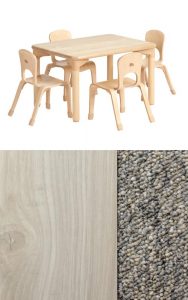Have you ever been reminded of an Abbott and Costello skit when talking with your three year old? Ever fallen down a rabbit hole of questions, only to hit the rock bottom of your ability to come up with an answer? If so, you have encountered the phenomenon that is the "Why?" stage. Where does this dizzying vortex of inquiry come from? And, more importantly, when will it stop?
"Get your shoes on, honey. We're going to the store."
"Why?"
"Because we need groceries."
"Why?"
"Because we ate up all our food."
"Why?"
"Because we were hungry."
"Why?"
Maria Montessori provides us with profound insight into the seismic shift in children's cognitive development that takes place around the third birthday. Before this milestone, infants and toddlers are "unconscious, absorbent" learners who acquire skills such as walking and talking without self-awareness or intention, by simply following their own innate desire for autonomy and imitating others in their environment. Around age three, however, they become "conscious" learners, who actively seek knowledge and master new skills through purposeful, deliberate inquiry and practice. It is around this time that many children stumble upon a magical word; one that elicits a seemingly endless wellspring of useful information from adults. Thus begins the litany: "Why? Why? Why?”
In truth, a child's "why?" is not the same question we ask as adults. Yes, children do crave our explanations as they seek to understand their world, but they are not necessarily expecting any elegant, logical, or scientific answers. More often, "why?" translates to: "I'm curious about this topic. I like it when you explain what will happen next. I cherish your attention and the love I feel from you when you talk to me. I want to hear all of the words you know so that I can learn how to use them, too. I want to use long sentences and have conversations, just like you do. Let's practice talking together!" Like a game of verbal ping-pong, each thread of "whys" and responses helps children develop engaging, socially adept conversation skills that will serve them well throughout their lives.
For a great perspective on the whys behind "why," click here for a great article from child psychologist Dr. Alan Green. And to learn more about Montessori's research on the developing brain, please visit our Parent Resource Library, or ask your child's teacher at GMS. (Why? Because we love talking about this stuff.)
Simon Sinek, best-selling author and renowned lecturer, made his mark with a famous TED Talk encouraging leaders and organizations to “Start with Why.” Knowing “what” you do and “how” you do it does not matter if you don’t know “why” you’re doing it. As we embark on a new journey for Greensboro Montessori School through 70 in 70: The Fund for GMS, we’re excited to examine Mr. Sinek’s model of what, how and why as it relates to revitalizing our Primary classrooms. This exploration provides transparency, meaning and context … all of which are necessary to effectively educate our children and be responsible stewards of our donors’ contributions.

An example of the table and chairs, wood-grain tile and carpet selected for our Primary classrooms should we raise $70,000 by December 31, 2017.
What: One of the main goals of 70 in 70: The Fund for GMS is to revitalize our Primary classroom environments. “Revitalize” can be ambiguous, so let’s unpack this concept. If we raise $70,000 in 70 days, all four Primary classrooms will receive:
- New tables, chairs and shelving made from durable, sustainably harvested solid-wood and featuring a contemporary yet comfortable aesthetic specifically designed with the 3- to 6-year-old at heart
- New flooring including bonded, cushioned carpet and resilient, wood-grain vinyl tiling
- New countertops at every sink and snack station
- An enhanced outdoor classroom, with the addition of an outdoor sink and chalkboard to the Primary garden
In addition to the Primary classroom revitalization, we will also award faculty grants to the professional educators in our other divisions: Toddler, Lower ELementary, Upper Elementary and Junior High. This democratic school process includes a committee of students, faculty, and administration who review and approve grant requests from faculty. Grants focus on specific needs that will propel a classroom's or division's curriculum to the next level.
How: It’s simple - not easy - but simple. By raising $70,000 by December 31, 2017, we will have the funding to support this immediately actionable, strategic imperative for our School, the Primary classroom revitalization. $70,000 also supports our powerful tradition of awarding faculty grants.
Why: The environments in which we live, work and play directly influence the levels of joy, productivity and success we experience in each of these endeavors. Think about the time and effort we, as adults, place in building warm, pleasant and efficient environments for ourselves, our families and guests. The spaces we design impart value on the people who spent time in them.
The same goes for a child’s classroom. While we may take this for granted, Maria Montessori revolutionized education by designing her classroom environments for her students, not for the teachers. Furthermore, she trained teachers in classroom design so they could create environments that optimize student learning. But why?
Students require freedom of movement in their living and learning spaces. Classrooms must have child-sized small tables for group work, tables for a single student to work independently, and chairs that can easily be moved by the student. Students are able to make themselves comfortable and find their place in the room where they best work.
Classroom furniture also facilitates learning attention to detail, control of error, and self-regulation. Students receive lessons on how to carry chairs safely; how to walk in a controlled manner carefully navigating friends and materials laid out on rugs; and how to learn when a work or space is not available in a specific moment. Carrying a chair without dropping it, knocking a friend, or disturbing a group is a challenge to be repeated for success. And is all done by design.
Another key element in a Montessori classroom is the consideration of aesthetics: beauty and simplicity are what draw the child’s interest into the purposeful work available throughout the classroom. Each and every day, our teachers prepare their learning environment by arranging materials on the shelves in an order and sequence that facilitates their use. Our teachers’ goal is to connect their students to the materials, which then become the active “teacher” of abstract concepts giving the student opportunities for discovery-based learning.
In describing the importance of the teaching-role played by the materials in the classroom, Dr. Montessori wrote: “As a teacher, the material is always ready, always patient, constant in mood, and prepared to repeat its lesson. It is truly a striking teacher in that it imparts a deep mastery, constantly leading to analysis and discovery until the root of the problem is reached. The pupil will never again forget that lesson.”
An investment in our students’ learning environment is an investment in them. Upon crossing the threshold of their rejuvenated classrooms for the first time, our Primary students will know they are valuable members of our community. The improved aesthetics of their classrooms will instill a greater sense of purpose, clarity, motivation, ownership and belonging in each of them, and their learning will be maximized.
At face value, flooring, furniture and countertops may not seem important or inspirational. But when we know why design and beauty play a leading a role in the Montessori classroom, we understand the significance of our investment. (We also see how Montessori’s classroom design remains on the cutting edge of education.) Just like gathering places of our adult lives - living rooms, kitchens, offices, conference rooms, even that special corner at your local coffee shop - prepare us for our best work, so do our classrooms for our children.
Great schools are made up of great educators, and when you step into Catherine Froelich’s classroom in the Primary division you can feel it. There is laughter, there is joy, and there is learning all around. Watching her move around a classroom of three, four and five year olds is like watching a busy bee tending to all of the cells of the hive. She carefully and consciously interacts with each individual student as she weaves her way through the tables and chairs and small work rugs on the floor. “In Montessori, I love that the children can work at their own pace and I get to be the facilitator. They can work on the floor and they can move around the room as they need to,” Catherine shared.
Catherine has a fun-loving, adventurous and out-going personality, and when you delve below the surface you learn that her bubbly nature is paired with a deeply personal commitment to the Montessori approach to education. “When I was growing up, I didn’t learn like everybody else and I knew it. I had teachers that sent me out of the classroom a lot. So I have empathy for kids who learn differently. I work to create an learning environment where each child is allowed to be their own person, quirks and all.”
Being a master at facilitating learning in the classroom is just one element that makes her an extraordinary educator. Catherine also has a deep appreciation for the role of parent partnership in shaping a successful school experience. According to Catherine, “building trust with the child and with the family is the most important thing that I do." This fall she worked with fellow faculty member, Tracy Carr, to translate this passion into a presentation on family communication at the 2017 Annual Educators Conference of the NC Association of Independent Schools.
Her work to build trusting and lasting relationships with the families resonates with families long after they leave her class. Lower Elementary parent, Mary Kristen Clark, shared this special sentiment about Catherine:
"In the three years our son, Avery, spent with Catherine in Primary, not a day went by that I didn't thank my lucky stars that his growth and development was influenced by such a phenomenal teacher. He walked through her door a hesitant preschooler and left a confident boy. Catherine instilled in him a love of learning and validated the merits of the Montessori approach to education for us. Isaac and I will forever be grateful for her guidance and patience, not only for our son but for us, as well!”
Catherine has been a member of the Primary faculty since 2011 and holds a bachelor’s degree in elementary education from UNC Chapel Hill and a Montessori teaching credential from the Santa Monica Montessori Institute in California. In recent years, she has also emerged as a faculty leader and is currently serving as the Primary Division Head. In reflecting on her role as division head, she said:
"I enjoy being part of something new and laying the ground work for a new vision for the future! Our team is so excited about the plans for refurbishing the Primary classrooms with proceeds from our new fundraising campaign 70 in 70: The Fund for GMS. The children will be the main beneficiaries of this project. It will make them feel valued! I hope that all of our families will find a way to participate whether their child is a past, present or future Primary student."
If you are a parent of a Primary student then you may have wondered about the square pieces of paper with tracings of geometric shapes that your child brings home in her work folder. When she tells you what it is, you may ask her to repeat herself because it sounds like she is calling them "metal insects." Secretly, you think to yourself, "funny, these don't look anything like insects." And you would be right!
These designs are made with a fundamental Montessori material known as the Metal Insets.
The Metal Insets, predominantly found in the Primary and Lower Elementary classrooms, are used to develop a core set of skills that build upon one another in sequence. In the Primary classroom, this material is the first direct preparation for handwriting. The introduction to the Metal Insets usually follows a lot of indirect preparation for handwriting that is developed through the use of the Practical Life materials and the Sensorial materials (e.g. the three finger pincer grasp used with the small tongs, eye dropper, and knobbed cylinders aids the child in correct pencil grip).
Becoming proficient in using a writing instrument is a long process. When children work with the Metal Insets, they engage and practice a host of fine motor skills including lightness of touch, evenness of pressure, continuity of line, and control of line. Not to mention, this work also aids children in the development of concentration, memory and a sense of order (all necessary for executive function).
The physical material that is displayed on the shelf is both beautiful and organized in appearance. The Metal Inset materials consist of ten geometric shapes that each fit into a corresponding metal frame (like a puzzle piece). There are five straight-lined figures and five curve-lined figures: square, triangle, rectangle, pentagon, trapezium, circle, oval, ellipse, curvilinear triangle, and quatrefoil. The shapes correspond directly to the curves and angles found in the letters of the alphabet.
Beyond preparing and strengthening the hand for handwriting, there are 7 different presentations of Metal Insets that increase with difficulty starting with the simple tracing of shapes to the gradation, design and superimposition of shapes and colors. Lower Elementary students often revel in making intricate patterns by combining the shapes and observing their geometric proportions and relationships to one another, laying the foundation for true work in geometry.
Click here to learn more about the Metal Insets on www.montessoridaoshi.com


